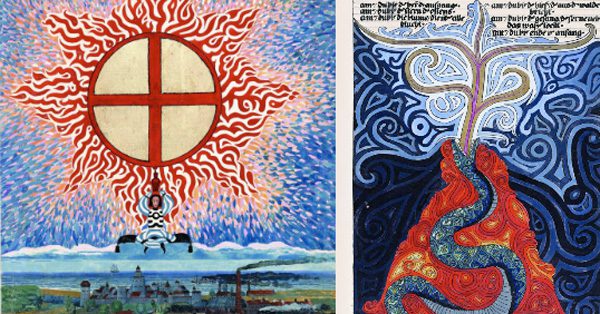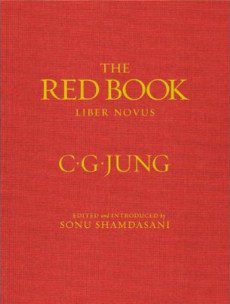 In Jungian circles, it was as hotly anticipated as the new Dan Brown thriller, and the story of how it came to light reads like one to match. The Red Book (public library) — or Liber Novus (Latin for “New Book”), as it’s known by his disciples — was created by Swiss psychoanalyst and theorist Carl Jung over a main period of six years beginning in 1913. Like a cross between an illuminated manuscript, personal journal, and a tome of mini Buddhist mandalas, The Red Book provides a singular and extraordinary insight into one of the 20th century’s most celebrated minds. What’s more, it documents what happened when one of the world’s premier psychoanalysts lost his soul, according to some accounts.
In Jungian circles, it was as hotly anticipated as the new Dan Brown thriller, and the story of how it came to light reads like one to match. The Red Book (public library) — or Liber Novus (Latin for “New Book”), as it’s known by his disciples — was created by Swiss psychoanalyst and theorist Carl Jung over a main period of six years beginning in 1913. Like a cross between an illuminated manuscript, personal journal, and a tome of mini Buddhist mandalas, The Red Book provides a singular and extraordinary insight into one of the 20th century’s most celebrated minds. What’s more, it documents what happened when one of the world’s premier psychoanalysts lost his soul, according to some accounts.
We first heard about The Red Book via an article of epic proportions about its history in The New York Times. Jung, the founder of modern analytical psychology, started the book at a time in his life described alternately (depending on the account) as a mid-life crisis, a psychotic break, or a reflection of the chaos that enveloped Europe during World War I.
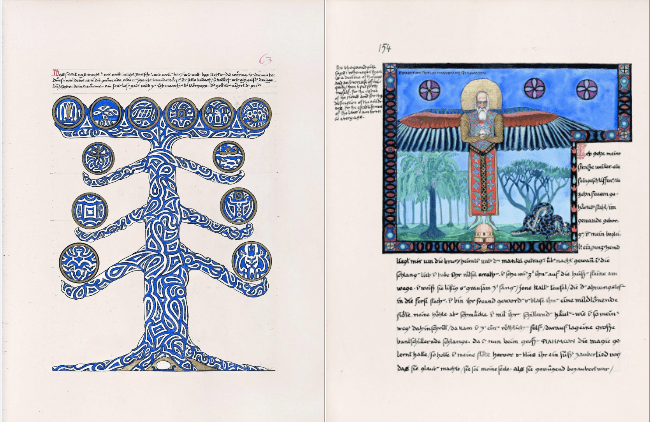
Regardless of your position on its origins, it’s hard to resist the book’s intrigue, or its illustrations. Within the pages of the original, physical leather-bound red book, Jung practiced with himself what he was doing daily in his patient practice: taking deliberately deep dives into his murky unconscious and recording everything when he emerged.
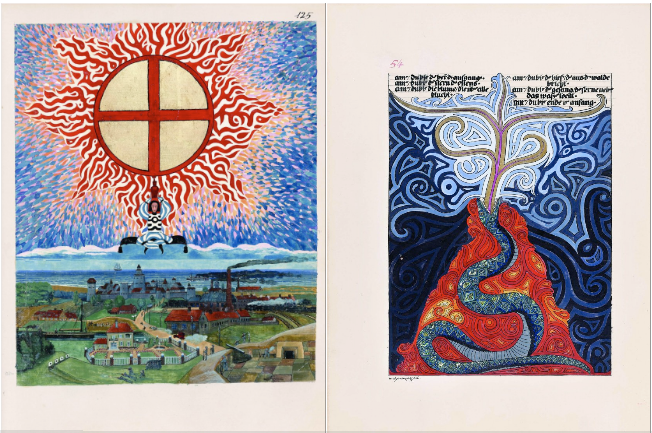
Intricately painted pages alternate with accounts of his dreams, both sleeping and waking, and the results were bizarre enough that his heirs spent decades treating the tome like samizdat following his death in 1961. (The Jung family drama is reason enough to read the excellent Times piece, which captures the almost absurd sense of secrecy surrounding the book and its embattled history.)
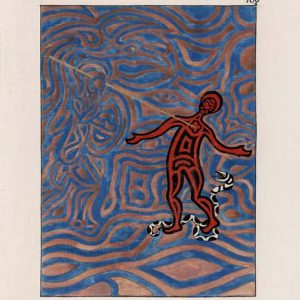 Jung’s adherents ultimately won the battle, which is how The Red Book finally appeared in print last October. Now, after being subjected to scholarly treatment and high-resolution scans, Jung’s protean visions can be a part of your personal library. In the course of its 205 runic pages he takes a trippy journey accompanied by spirit guides, depicted in a manner that somehow simultaneously recalls D’aulaire’s Book of Greek Myths and so-called outsider art. And now The Red Book has also made the physical trip to New York City’s Rubin Museum of Art, where it’s currently on display until February 15th.
Jung’s adherents ultimately won the battle, which is how The Red Book finally appeared in print last October. Now, after being subjected to scholarly treatment and high-resolution scans, Jung’s protean visions can be a part of your personal library. In the course of its 205 runic pages he takes a trippy journey accompanied by spirit guides, depicted in a manner that somehow simultaneously recalls D’aulaire’s Book of Greek Myths and so-called outsider art. And now The Red Book has also made the physical trip to New York City’s Rubin Museum of Art, where it’s currently on display until February 15th.
What we’re even more jazzed about, though, is the programming that the Rubin planned around the exhibition. In a series of talks called The Red Book Dialogues, the museum curated more than 30 fantastic pairings of cultural creatives and Jungian analysts to talk about the book, themselves, and the collective unconscious. Many of these talks are now available as podcasts from one of our favorite NPR station sites, WNYC.
Hear what happens when a range of famous names do cold readings of images from the book. Author Alice Walker, director Charlie Kauffman (“My first instinct was torture, but that’s me”), and Smashing Pumpkins frontman Billy Corgan each offer fascinating free associations on Jung’s koans. We’re hopeful that more talks will come online soon. (In fact, might we be so bold as to suggest starting with composer John Adams, Twitter co-founder Jack Dorsey, designer — and TEDster — Stefan Sagmeister, and comedian Sarah Silverman?)
Explore your own unconscious reactions to The Red Book via a preview, the Rubin’s film series, WNYC’s audio podcasts, or if you’re lucky enough to be able to make the trip, in person.
 Kirstin Butler is writing an adaptation of Gogol for the Google era called Dead SULs, but when not working spends far, far too much time on Twitter. She currently lives in Cambridge, MA.
Kirstin Butler is writing an adaptation of Gogol for the Google era called Dead SULs, but when not working spends far, far too much time on Twitter. She currently lives in Cambridge, MA.


